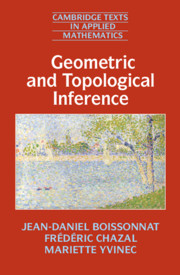Bibliography
Published online by Cambridge University Press: 14 September 2018
Summary

- Type
- Chapter
- Information
- Geometric and Topological Inference , pp. 224 - 230Publisher: Cambridge University PressPrint publication year: 2018
References
 from noisy data samples. In Proc. 21st Symp. Comp. Geom., Pisa, Italy, pages 255–262, 2005.Google Scholar
from noisy data samples. In Proc. 21st Symp. Comp. Geom., Pisa, Italy, pages 255–262, 2005.Google Scholar


